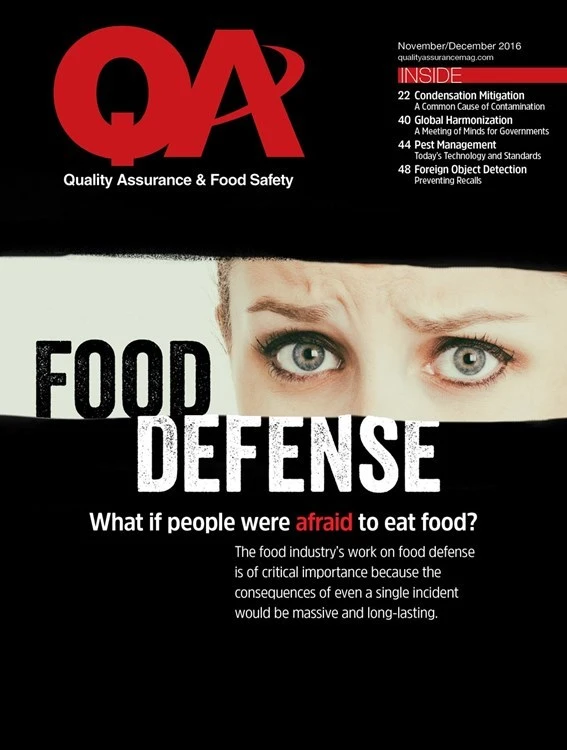
By Akhila Vasan
Food safety culture has been a buzzword and the talk of the town at many recent food industry conferences. Up until now we have focused largely on what food safety culture is and why it is important. But having been saturated with talks on its importance, the industry is now ready to implement practices within an organization that can lead to improved and enhanced food safety behaviors. It is a way to change the mindset of people at all levels across all functionalities in the food industry, and to get them to start acting to impact the food safety outcomes of their organization. It includes developing strategies to minimize risk and protect the brand, while empowering workers to make the right decisions so they are invested in producing safe food in their roles.
However, before making any changes to impact the culture in a company, it is necessary to understand the current state of affairs. One can think of this as setting a baseline, then using it to measure change over time. Employee behavior (i.e., strengths and weaknesses) can be measured by self assessments, and it is important to note that, while we want to improve the weaknesses, we definitely want to build on the inherent strengths within the company. In addition, there are several tools available to measure culture, and the maturation model is one of them. It provides an opportunity to develop proactive programs so that one can move along the maturity curve, making it a dynamic model.
A key point in measuring the food safety culture of an organization is the bias associated with scoring or providing a numerical value for a behavior. Tools which provide scores must be looked at with caution because of the dynamic nature of a food safety culture and its inherent variability, given the various factors that affect the culture in an organization. This is especially problematic and could provide a false sense of security, as a number is a static point and one can overestimate value based on a numerical score. It also ignores the subcultures which contribute to behaviors that impact food safety.
People follow the behaviors of their peers. Having a strong food safety culture in an organization requires buy-in from senior leadership and anyone who makes strategic decisions within a food company, across functionalities. Cultivate Inc. Principal Lone Jespersen, who is a recognized expert in the area, advises that companies can begin the journey on food safety culture in three keys ways:
- Reacting to a crisis, and making changes in the face of a foodborne outbreak.
- Making changes because of leadership.
- Making changes as a result of financial implications.
A key point to note is that implementing food safety culture is a journey; it is not a one-time “check off the box” activity to meet a regulatory requirement. So a company with a strong food safety culture is continuously making changes in an organization, so as to change the mindsets and build upon the behaviors of their employees. In addition, the company is working as a cross-functional team to make decisions in an organization, as there is no way that one person or department knows everything about the facility. It is about acknowledging and assessing risks at multiple levels.

Additionally, the economic impacts of a strong food safety culture cannot be stressed enough, and simple outcomes such as finding metal or plastic contaminants cost much more that many actually believe of them. It is not only the price of the recall, but also the brand value that is affected.
Having a strong food safety culture is on virtually every company’s radar today, and some companies are further along than others in achieving this. An organization’s culture will influence how the people think about safety, not just individually but as a group; how they discuss and communicate food safety concerns with their peers and supervisors; and what they do when there is a threat to safety within their role.
This is an important topic for the industry, and it is of little wonder that industry members and experts across commodities are coming together in groups, such as the technical working groups of the Global Food Safety Initiative (GFSI) to find a harmonious solution. These groups of experts are evaluating various theoretical and practical components, and developing tools for stakeholders to understand and strengthen food safety culture.
GMA’s Science and Education Foundation, itself, is working with Cultivate and Alchemy Systems on an interactive workshop to improve food safety behaviors in an organization. The instructors are technical experts in organizational culture, food safety, risk assessment, and communication. The program includes an e-learning session, a practical one-day seminar, and follow-up virtual coaching sessions. For more information, email avasan@gmaonline.org.
The author is a Science & Education Foundation fellow and project manager, GMA.

Explore the December 2016 Issue
Check out more from this issue and find your next story to read.
Latest from Quality Assurance & Food Safety
- AFDO Webinar Series Offers Strategies for Difficult Times
- FDA, USDA Rehire Some Staff, Multiple Sources Report
- Nestlé Opens Arizona Beverage Factory and Distribution Center
- Ingredion Invests $100 Million in Indianapolis Plant to Improve Efficiency, Enable Texture Solutions Growth
- Eagle Unveils Redesigned Pipeline X-ray System
- USDA Invests Up To $1 Billion to Combat Avian Flu, Reduce Egg Prices
- Washington Cats Confirmed with HPAI as Investigation into Contaminated Pet Food Continues
- USDA Confirms Bird Flu Detected in Rats in Riverside





